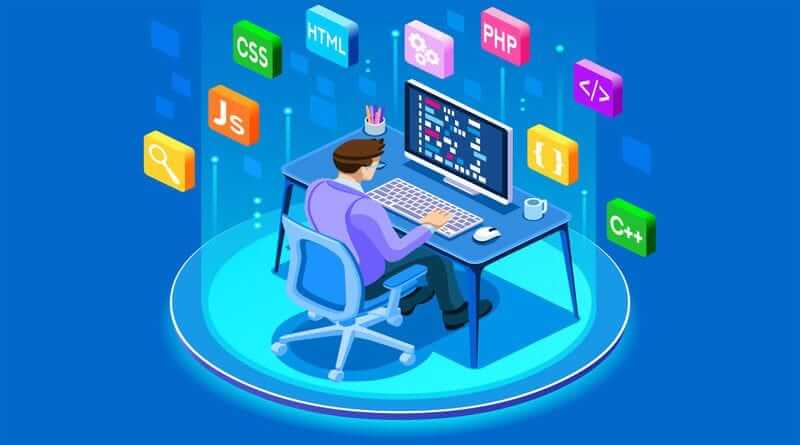the role of a full-stack developer has emerged as a cornerstone position. This versatile professional possesses the expertise to handle both front-end and back-end development, making them indispensable assets in today’s tech-driven industries. In this blog, we’ll delve into the realm of full-stack development, exploring its significance, key skills, and career prospects.
Understanding the Role of a Full-Stack Developer
What is a Full-Stack Developer?
A full-stack developer is a multifaceted professional proficient in both front-end and back-end technologies. They possess a comprehensive understanding of various programming languages, frameworks, and tools required to develop web applications from start to finish. Essentially, they bridge the gap between the user-facing aspects of an application (front end) and the underlying server-side functionalities (back end).
The Journey to Mastery: Skills Required for Full-Stack Development
Front-End Technologies
Mastering front-end development entails proficiency in languages such as HTML, CSS, and JavaScript. These languages form the backbone of web development, dictating the structure, presentation, and behavior of web pages. Additionally, familiarity with front-end frameworks like React, Angular, or Vue.js is crucial for building interactive and responsive user interfaces. Our service Software Product Development Services
Back-End Technologies
On the back-end side, full-stack developers work with server-side languages such as Node.js, Python, Ruby, or Java to handle data storage, application logic, and server management. They leverage frameworks like Express.js, Django, or Spring Boot to streamline development processes and ensure scalability and efficiency.
Databases
A strong grasp of database management is essential. They must be proficient in working with relational databases like MySQL, PostgreSQL, or SQL Server, as well as NoSQL databases such as MongoDB or Firebase. Understanding database design, querying, and optimization techniques is crucial for building robust and scalable applications.
Version Control Systems
Git enables collaborative development, facilitates code management, and ensures version control, thereby streamlining the development workflow and enabling seamless collaboration within development teams.
DevOps and Deployment
In today’s agile development landscape, familiarity with DevOps practices and deployment strategies is invaluable. Full-stack developers should be adept at configuring servers, managing deployment pipelines, and implementing continuous integration/continuous deployment (CI/CD) workflows to automate the deployment process and ensure smooth, reliable releases.
Advantages of Being a Full-Stack Developer
Versatility and Flexibility
One of the primary advantages of being a full-stack developer is versatility. By possessing proficiency in both front-end and back-end technologies, full-stack developers can seamlessly transition between different layers of the application stack, effectively troubleshooting issues and implementing solutions across the entire development spectrum.
Rapid Prototyping and Iteration
Full-stack developers excel at rapid prototyping and iteration, thanks to their comprehensive skill set. They can quickly translate design concepts into functional prototypes, iterate based on feedback, and implement changes across the entire application stack, thereby accelerating the development cycle and ensuring the timely delivery of high-quality products.
Enhanced Problem-Solving Abilities
The diverse nature of full-stack development cultivates strong problem-solving abilities. Full-stack developers are adept at identifying and addressing issues at both the front-end and back-end levels, leveraging their broad technical expertise to devise efficient solutions and optimize performance.
Career Growth Opportunities
With the increasing demand for versatile developers who can contribute to all aspects of the development process, full-stack developers enjoy ample career growth opportunities. Whether working as freelancers, joining startups, or advancing within established tech companies, full-stack developers are highly sought after for their ability to drive innovation and deliver results across diverse projects.
Challenges and Opportunities for Full-Stack Developers
Keeping Pace with Technological Advancements
The fast-paced nature of the tech industry means that full-stack developers must continuously update their skills and stay abreast of technological advancements. Whether it’s learning a new framework, mastering emerging technologies like blockchain or machine learning, or adapting to shifting industry trends, staying relevant is key to sustaining a successful career in full-stack development.
Balancing Depth and Breadth
While full-stack developers possess a broad skill set, there’s a risk of spreading oneself too thin. Balancing depth and breadth of expertise is essential, as focusing too much on breadth may result in superficial knowledge across multiple domains, while neglecting depth may limit one’s ability to tackle complex challenges effectively.
Collaboration and Communication
Effective collaboration and communication are paramount for full-stack developers, particularly in team settings. Clear communication with designers, back-end developers, and stakeholders is essential for aligning goals, addressing challenges, and delivering cohesive solutions that meet user needs and business objectives.
Conclusion
a rewarding journey that requires dedication, continuous learning, and adaptability. By mastering both front-end and back-end technologies, full-stack developers empower themselves to tackle diverse challenges, drive innovation, and contribute to the development of cutting-edge web applications. With their versatility, problem-solving abilities, and commitment to excellence, full-stack developers play a pivotal role in shaping the digital landscape of tomorrow.

